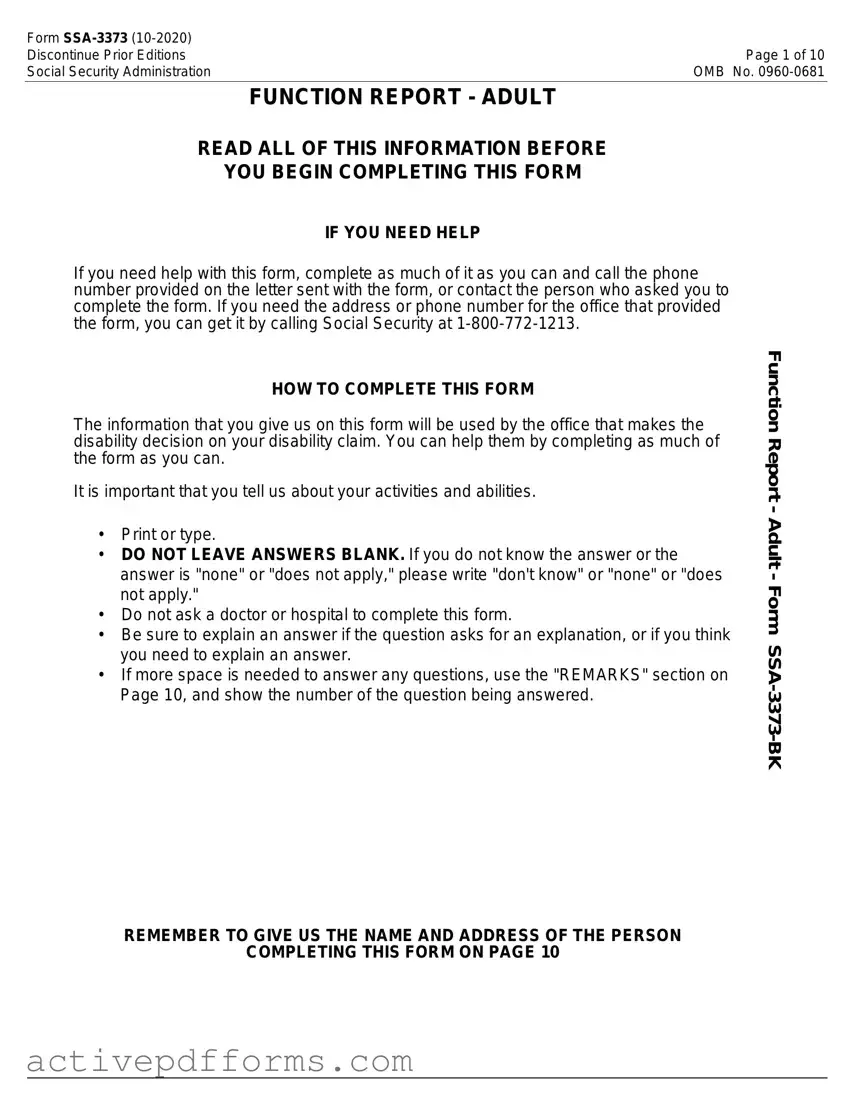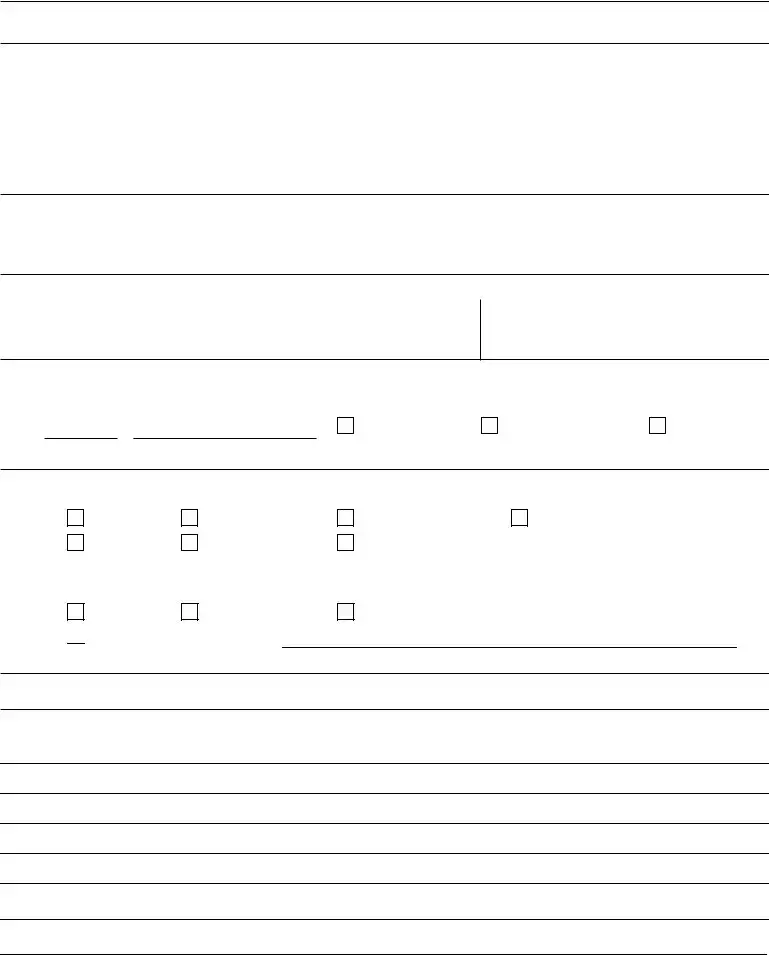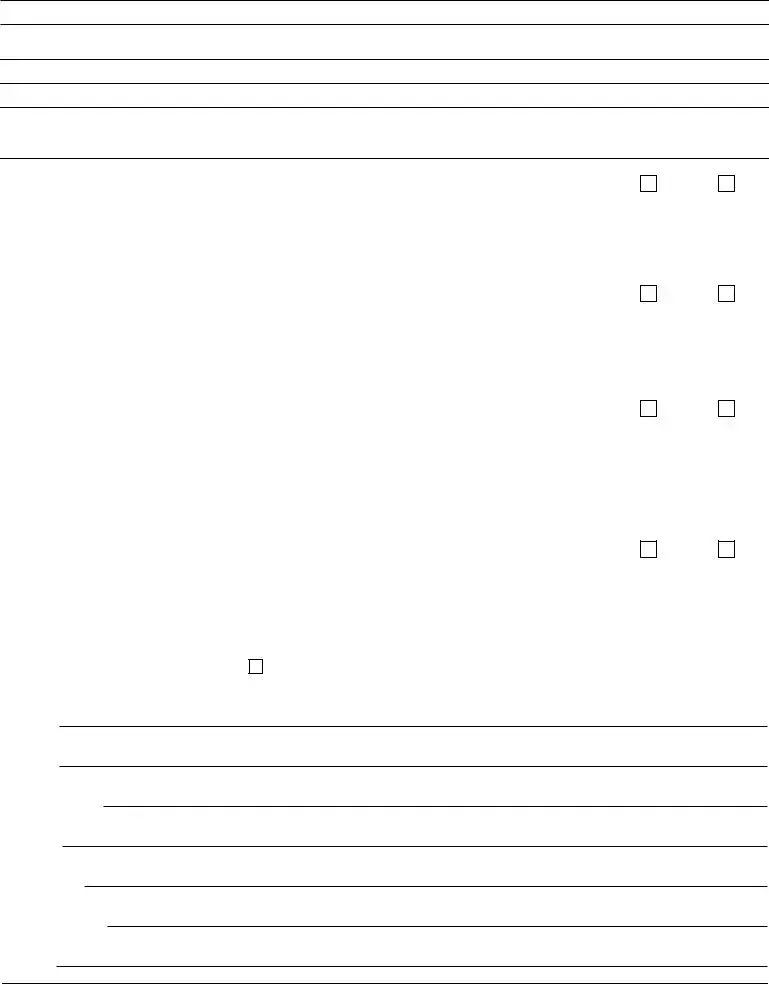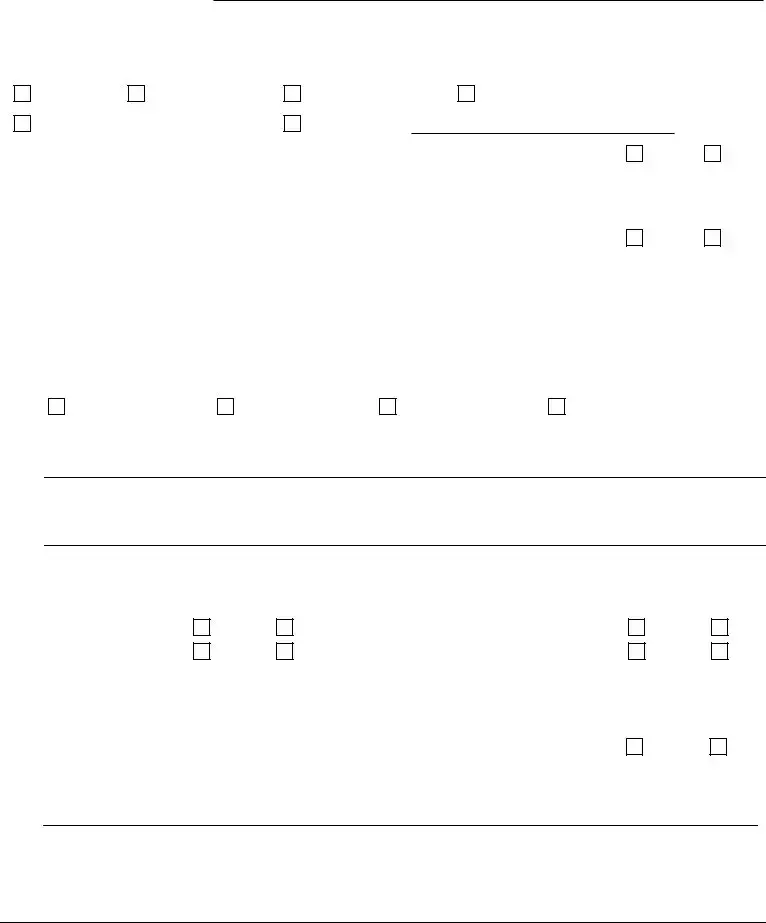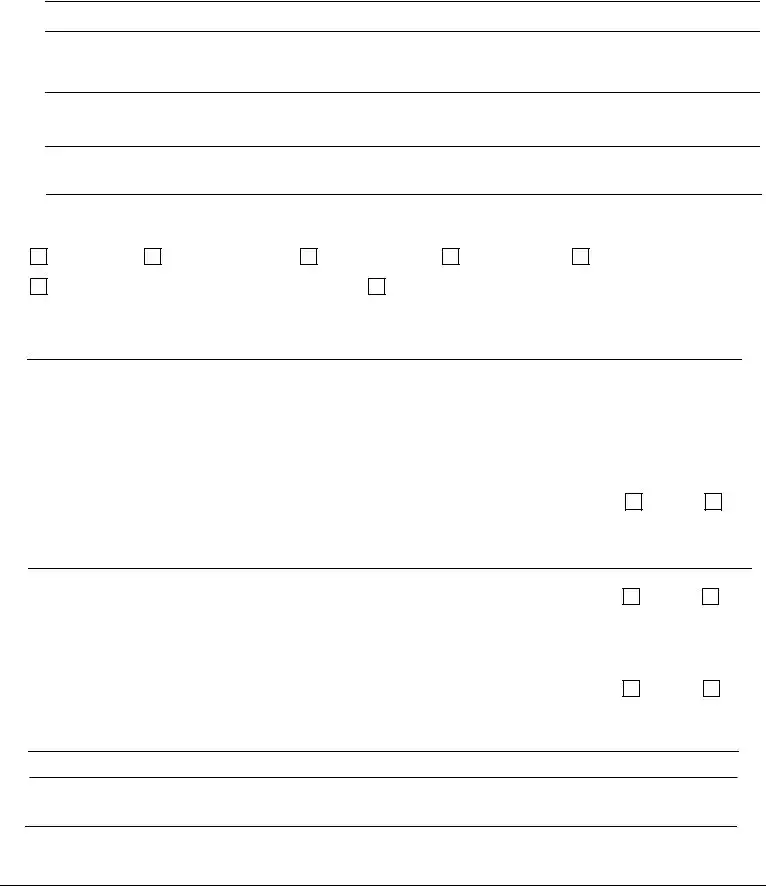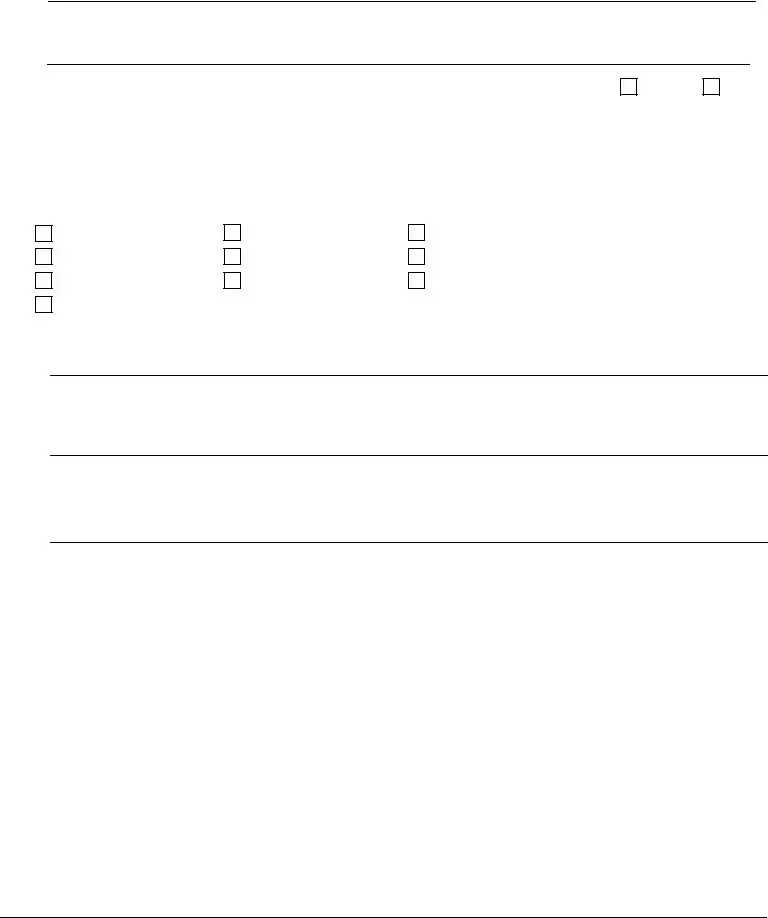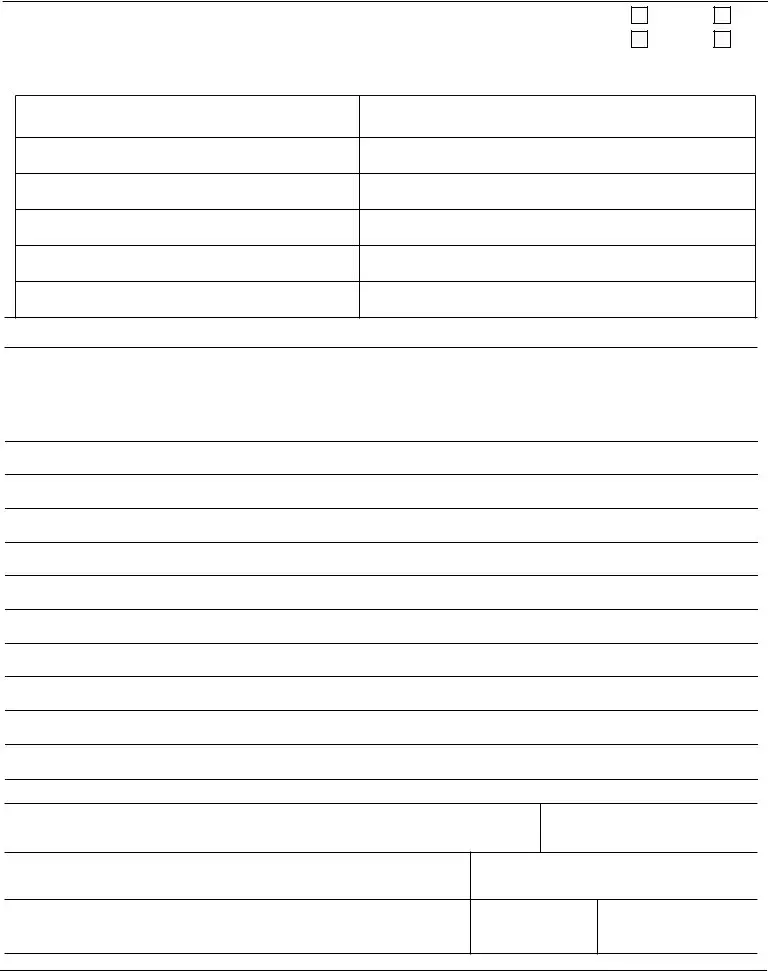Form SSA-3373 (10-2020) |
|
Discontinue Prior Editions |
Page 1 of 10 |
Social Security Administration |
OMB No. 0960-0681 |
FUNCTION REPORT - ADULT
READ ALL OF THIS INFORMATION BEFORE
YOU BEGIN COMPLETING THIS FORM
IF YOU NEED HELP
If you need help with this form, complete as much of it as you can and call the phone number provided on the letter sent with the form, or contact the person who asked you to complete the form. If you need the address or phone number for the office that provided the form, you can get it by calling Social Security at 1-800-772-1213.
HOW TO COMPLETE THIS FORM
The information that you give us on this form will be used by the office that makes the disability decision on your disability claim. You can help them by completing as much of the form as you can.
It is important that you tell us about your activities and abilities.
•Print or type.
•DO NOT LEAVE ANSWERS BLANK. If you do not know the answer or the answer is "none" or "does not apply," please write "don't know" or "none" or "does not apply."
•Do not ask a doctor or hospital to complete this form.
•Be sure to explain an answer if the question asks for an explanation, or if you think you need to explain an answer.
•If more space is needed to answer any questions, use the "REMARKS" section on Page 10, and show the number of the question being answered.
Function Report - Adult - Form SSA-3373-BK
REMEMBER TO GIVE US THE NAME AND ADDRESS OF THE PERSON
COMPLETING THIS FORM ON PAGE 10
Form SSA-3373 (10-2020) |
Page 2 of 10 |
|
|
Privacy Act Statements
Collection and Use of Personal Information
Sections 205(a), 223(d), and 1631 of the Social Security Act, as amended, allow us to collect this information. Furnishing us this information is voluntary. However, failing to provide all or part of the information may prevent an accurate and timely decision on any claim filed.
We will use the information you provide to make a determination of eligibility for benefits. We may also share your information for the following purposes, called routine uses:
•To contractors and other Federal agencies, as necessary, for the purpose of assisting the Social Security Administration (SSA) in the efficient administration of its programs; and
•To applicants, claimants, prospective applicants or claimants, other than the data subject, their authorized representatives or representative payees to the extent necessary to pursue Social Security claims and to representative payees when the information pertains to individuals for whom they serve as representative payees, for the purpose of assisting SSA in administering its representative payment responsibilities under the Act and assisting the representative payees in performing their duties as payees, including receiving and accounting for benefits for individuals for whom they serve as payees.
In addition, we may share this information in accordance with the Privacy Act and other Federal laws. For example, where authorized, we may use and disclose this information in computer matching programs, in which our records are compared with other records to establish or verify a person's eligibility for Federal benefit programs and for repayment of incorrect or delinquent debts under these programs.
A list of additional routine uses is available in our Privacy Act System of Records Notices (SORN) 60-0089, entitled Claims Folders System, as published in the Federal Register (FR) on April 1, 2003, at FR 15784, and 60-0320, entitled Electronic Disability Claim File, as published in the FR on December 22, 2003, at 68 FR 71210. Additional information, and a full listing of all our SORNs, is available on our website at https://ssa.gov/privacy.
Paperwork Reduction Act Statement - This information collection meets the requirements of 44 U.S.C. § 3507, as amended by section 2 of the Paperwork Reduction Act of 1995. You do not need to answer these questions unless we display a valid Office of Management and Budget control number. We estimate that it will take about 61 minutes to read the instructions, gather the facts, and answer the questions. SEND OR BRING THE COMPLETED FORM TO
YOUR LOCAL SOCIAL SECURITY OFFICE. You can find your local Social Security office through SSA's website at www.socialsecurity.gov. Offices are also listed under U. S.
Government agencies in your telephone directory or you may call Social Security at
1-800-772-1213 (TTY 1-800-325-0778). You may send comments regarding this burden estimate or any other aspect of this collection, including suggestions for reducing this burden to: SSA, 6401
Security Blvd, Baltimore, MD 21235-6401. Send only comments relating to our time estimate to this address, not the completed form.
PLEASE REMOVE THIS SHEET BEFORE RETURNING
THE COMPLETED FORM.
Form SSA-3373 (10-2020) |
|
Discontinue Prior Editions |
Page 3 of 10 |
Social Security Administration |
OMB No. 0960-0681 |
FUNCTION REPORT - ADULT
How your illnesses, injuries, or conditions limit your activities
For SSA Use Only
Do not write in this box.
Anyone who makes or causes to be made a false statement or representation of material fact for use in determining a payment under the Social Security Act, or knowingly conceals or fails to disclose an event with an intent to affect an initial or continued right to payment, commits a crime punishable under Federal law by fine, imprisonment, or both, and may be subject to administrative sanctions.
SECTION A - GENERAL INFORMATION
1. NAME OF DISABLED PERSON (First, Middle Initial, Last) |
2. SOCIAL SECURITY NUMBER |
3.YOUR DAYTIME TELEPHONE NUMBER (If there is no telephone number where you can be reached, please give us a daytime number where we can leave a message for you.)
Your Number |
Message Number |
None |
Area Code Phone Number
4. a. Where do you live? (Check one.)
House |
Apartment |
Boarding House |
Nursing Home |
Shelter |
Group Home |
Other (What?) |
|
|
|
|
|
|
b. With whom do you live? (Check one.)
Alone |
With Family |
With Friends |

 Other (Describe relationship.)
Other (Describe relationship.)
SECTION B - INFORMATION ABOUT YOUR ILLNESSES, INJURIES, OR CONDITIONS
5. How do your illnesses, injuries, or conditions limit your ability to work?
Form SSA-3373 (10-2020) |
Page 4 of 10 |
SECTION C - INFORMATION ABOUT DAILY ACTIVITIES
6. Describe what you do from the time you wake up until going to bed.
7. Do you take care of anyone else such as a wife/husband, children, grandchildren, |
Yes |
No |
|
|
|
|
|
parents, friend, other? |
|
|
|
|
|
|
|
|
|
|
|
|
|
|
If "YES," for whom do you care, and what do you do for them? |
|
|
|
|
|
|
|
|
|
|
|
8. Do you take care of pets or other animals? |
Yes |
No |
|
|
|
|
|
If "YES," what do you do for them? |
|
|
|
|
9. |
|
|
|
|
Does anyone help you care for other people or animals? |
|
|
|
|
|
|
If "YES," who helps, and what do they do to help? |
Yes |
No |
|
|
|
|
|
|
|
|
10. |
What were you able to do before your illnesses, injuries, or conditions that you can't do now? |
|
|
|
|
|
|
|
|
|
|
|
|
11. |
Do the illnesses, injuries, or conditions affect your sleep? |
Yes |
No |
|
|
|
|
If "YES," how? |
|
|
|
|
|
|
|
|
|
|
|
|
|
12. |
PERSONAL CARE (Check here |
if NO PROBLEM with personal care.) |
|
|
|
a. Explain how your illnesses, injuries, or conditions affect your ability to: Dress
Bathe
Care for hair
Shave
Feed self
Use the toilet
Other
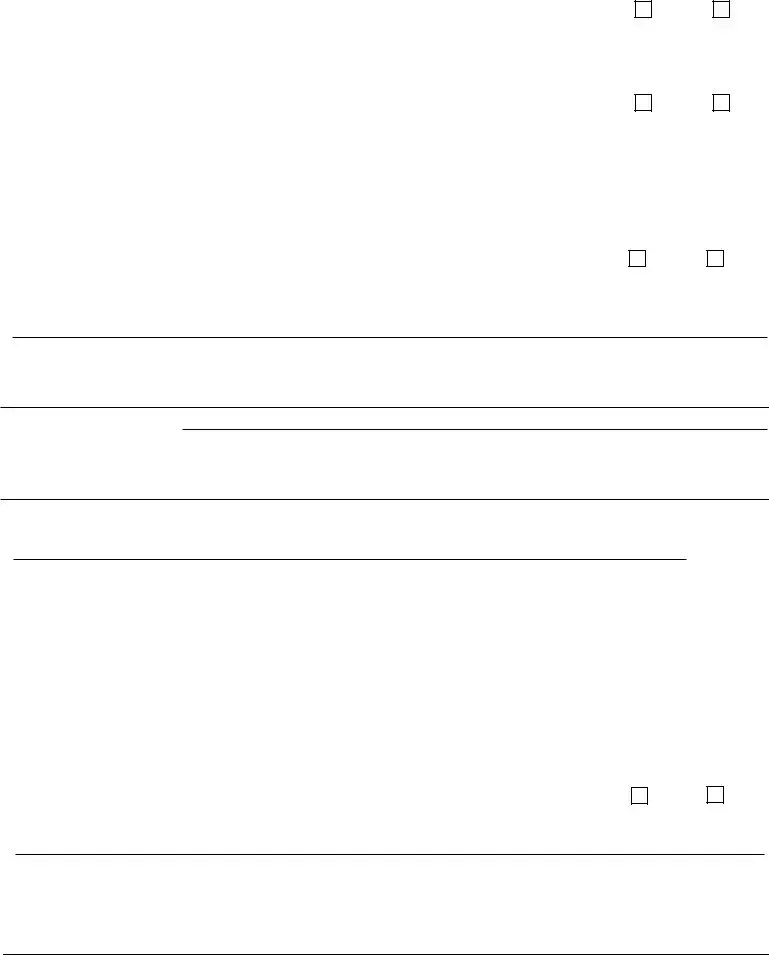
Form SSA-3373 (10-2020) |
|
Page 5 of 10 |
|
|
|
|
b. Do you need any special reminders to take care of personal |
Yes |
No |
|
needs and grooming? |
|
If "YES," what type of help or reminders are needed? |
|
|
|
|
|
|
c. Do you need help or reminders taking medicine? |
Yes |
No |
|
If "YES," what kind of help do you need? |
|
|
|
|
|
|
13. MEALS |
|
|
a. Do you prepare your own meals? |
Yes |
No |
If "Yes," what kind of food do you prepare? (For example, sandwiches, frozen dinners, or complete meals with several courses.)
How often do you prepare food or meals? (For example, daily, weekly, monthly.)
How long does it take you?
Any changes in cooking habits since the illness, injuries, or conditions began?
b. If "No," explain why you cannot or do not prepare meals.
14.HOUSE AND YARD WORK
a. List household chores, both indoors and outdoors, that you are able to do. (For example, cleaning, laundry, household repairs, ironing, mowing, etc.)
b. How much time does it take you, and how often do you do each of these things?
c. Do you need help or encouragement doing these things? |
Yes |
No |
If "YES," what help is needed? |
|
|
d. If you don't do house or yard work, explain why not.
Form SSA-3373 (10-2020) |
Page 6 of 10 |
|
|
15. GETTING AROUND
a. How often do you go outside?
If you don't go out at all, explain why not.
b. When going out, how do you travel? (Check all that apply.) |
|
Walk |
Drive a car |
Ride in a car |
Ride a bicycle |
Use public transportation |
Other (Explain) |
c. When going out, can you go out alone?
If "NO," explain why you can't go out alone.
d. Do you drive?
If you don't drive, explain why not.
16.SHOPPING
a. If you do any shopping, do you shop: (Check all that apply.)
In stores |
By phone |
By mail |
By computer |
b. Describe what you shop for. |
|
|
|
c. How often do you shop and how long does it take?
17. MONEY |
|
|
|
|
|
a. Are you able to: |
|
|
|
|
|
|
Pay bills |
Yes |
No |
Handle a savings account |
Yes |
No |
|
Count change |
Yes |
No |
Use a checkbook/money orders |
Yes |
No |
|
Explain all "NO" answers. |
|
|
|
|
|
|
|
|
|
b. Has your ability to handle money changed since the illnesses, |
Yes |
No |
injuries, or conditions began? |
|
|
|
|
|
If "YES," explain how the ability to handle money has changed. |
|
|
Form SSA-3373 (10-2020) |
Page 7 of 10 |
|
|
18.HOBBIES AND INTERESTS
a.What are your hobbies and interests? (For example, reading, watching TV, sewing, playing sports, etc.)
b.How often and how well do you do these things?
c.Describe any changes in these activities since the illnesses, injuries, or conditions began.
19.SOCIAL ACTIVITIES
a. How do you spend time with others? (Check all that apply.)
In person |
On the phone |
Email |
Texting |
Mail |
Video Chat (for example Skype or Facetime) |
Other (Explain) |
|
|
b. Describe the kinds of things you do with others.
How often do you do these things?
c. List the places you go on a regular basis. (For example, church, community center, sports events, social groups, etc.)
|
|
|
No |
Do you need to be reminded to go places? |
Yes |
How often do you go and how much do you take part? |
|
|
Do you need someone to accompany you?
If "YES", explain.
d. Do you have any problems getting along with family, friends, neighbors, or others? If "YES," explain.
e. Describe any changes in social activities since the illnesses, injuries, or conditions began.
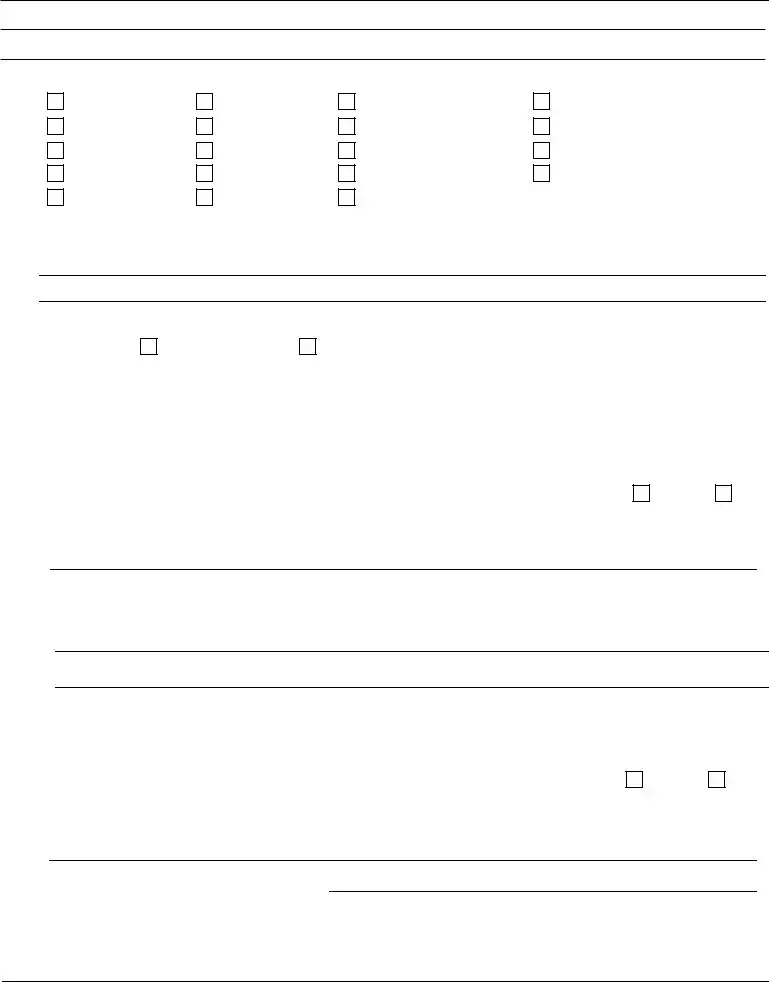
Form SSA-3373 (10-2020)Page 8 of 10
SECTION D - INFORMATION ABOUT ABILITIES
20. a. Check any of the following items that your illnesses, injuries, or conditions affect:
Lifting |
Walking |
Stair Climbing |
Understanding |
Squatting |
Sitting |
Seeing |
Following Instructions |
Bending |
Kneeling |
Memory |
Using Hands |
Standing |
Talking |
Completing Tasks |
Getting Along With Others |
Reaching |
Hearing |
Concentration |
|
Please explain how your illnesses, injuries, or conditions affect each of the items you checked. (For example, you can only lift [how many pounds], or you can only walk [how far])
|
|
|
|
|
|
|
|
|
b. Are you: |
Right Handed? |
Left Handed? |
|
|
|
c. How far can you walk before needing to stop and rest? |
|
|
|
|
|
|
|
|
|
|
|
|
If you have to rest, how long before you can resume walking? |
|
|
|
|
|
|
|
|
|
|
d. For how long can you pay attention? |
|
|
|
|
|
e. Do you finish what you start? (For example, a conversation, chores, |
Yes |
No |
|
reading, watching a movie.) |
|
|
|
|
|
|
|
|
f. How well do you follow written instructions? (For example, a recipe.) |
|
|
|
g. How well do you follow spoken instructions?
h. How well do you get along with authority figures? (For example, police, bosses, landlords
or teachers.) |
|
|
i. Have you ever been fired or laid off from a job because of problems getting |
Yes |
No |
along with other people? |
|
|
If "YES," please explain. |
|
|
If "YES," please give name of employer.
Form SSA-3373 (10-2020) |
Page 9 of 10 |
|
|
j. How well do you handle stress?
k. How well do you handle changes in routine?
l. Have you noticed any unusual behavior or fears? |
Yes |
No |
|
If "YES," please explain. |
|
|
|
|
|
|
21. Do you use any of the following? (Check all that apply.) |
|
Crutches |
Cane |
Hearing Aid |
Walker |
Brace/Splint |
Glasses/Contact Lenses |
Wheelchair |
Artificial Limb |
Artificial Voice Box |
Other (Explain) |
|
|
|
|
|
Which of these were prescribed by a doctor?
When was it prescribed?
When do you need to use these aids?
Form SSA-3373 (10-2020) |
Page 10 of 10 |
|
|
22. Do you currently take any medicines for your illnesses, injuries, or conditions? |
Yes |
No |
If "YES, "do any of your medicines cause side effects? |
Yes |
No |
If "YES," please explain. (Do not list all of the medicines that you take. List only the medicines that cause side effects.)
SECTION E - REMARKS
Use this section for any added information you did not show in earlier parts of this form. When you are done with this section (or if you didn't have anything to add), be sure to complete the fields at the bottom of this page.
Name of person completing this form (Please print)
Address (Number and Street)
Date (MM/DD/YYYY)
Email address (optional)
